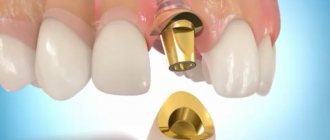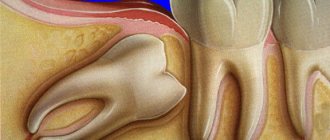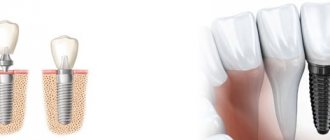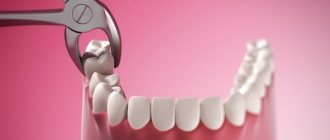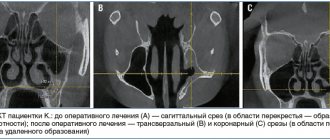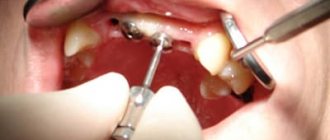Content
hide
1 Is bleeding normal?
2 Why does pathological bleeding develop?
3 Why does bleeding develop after implantation?
4 What to do if there is bleeding?
5 How to avoid bleeding after implantation?
Dental implantation is a dental procedure that is constantly evolving and is under the close attention of dentists around the world. Implants provide ample opportunities to restore aesthetics, functionality, and replace damaged dentition. After implantation, patients begin to smile again, feel free and confident. Like any surgical procedure, implantation is accompanied by some complications. One of them is bleeding. How to understand how dangerous this situation is and how to generally react to the appearance of blood from the gums?
Is bleeding normal?
Light bleeding immediately after manipulation is normal.
This is due to the invasive nature of the procedure and the peculiarities of the blood supply to the gum tissue. Before treatment, the doctor must warn you that this option is possible and you should not be afraid of the appearance of blood. On the contrary, this should give an understanding that in the first days it is necessary to carefully follow the recommendations and carry out hygiene procedures. Minor, low-intensity bleeding may bother you for several days and should not be alarmed. This situation is especially typical for those who have problems with blood clotting or fragile blood vessels. In addition to bleeding, the following symptoms will persist for several days:
- swelling of the gum tissue (but the entire cheek can also swell);
- hyperemia - redness of the gum mucosa;
- discomfort and pain in the tissues of the jaw, in the area of the installed implant.
If the healing process develops steadily, after 4–8 days the unpleasant symptoms gradually disappear. If the patient continues to experience pain, swelling increases, and the wound does not heal, it is imperative to visit the dentist.
How often does bleeding occur after bone grafting and sinus lifting?
Every person has experienced bleeding of varying severity at least once in their life. Bleeding is always accompanied by a violation of the integrity of the skin and other tissues in the body. Intense bleeding is a life-threatening condition and requires immediate stopping using special methods. In other cases, when the bleeding is small, the body's compensatory systems are triggered, which contribute to the formation of local microthrombi and the cessation of blood loss from the bleeding vessel.
Any osteoplastic operation, even such a microsurgical and minimally invasive one as a sinus lift, is accompanied by some damage to tissues and blood vessels and, naturally, it is accompanied by bleeding.
Controlled bleeding during surgery is a planned natural reaction of the body to tissue damage and can be easily and instantly stopped in an operating room. The severity of bleeding directly depends on the volume of the operation, its traumatic nature, and the number of implants being implanted. However, during sinus lifting and other osteoplastic surgeries, blood loss is minimal and does not affect the functioning of the body and the person’s well-being. Typically, the operation is bloodless and easily tolerated by patients.
After surgery, in the first few days it is considered normal to release a small amount of blood or ichor from the area of the postoperative wound. Also, the body’s natural reaction is:
- Pain in the surgical area, easily relieved with painkillers;
- Swelling, but not more than three days;
- Increase in body temperature to subfebrile levels (about 37-38);
- Hyperemia of tissue around the postoperative wound;
The above phenomena, during the normal course of the postoperative period, do not cause significant discomfort to the patient and are easily relieved with the help of the treatment prescribed by the surgeon. Positive dynamics should also be noted, that is, bleeding, swelling, pain and other unpleasant symptoms should subside within 3-7-10 days, depending on the complexity of the operation. Therefore, before undergoing a sinus lift or other type of bone grafting, you need to be prepared for the fact that at first there will be minor bleeding, swelling and pain, and not to panic if such symptoms appear.
Why does pathological bleeding develop?
The appearance of blood in the first hours after dental implantation is normal. The patient sees the saliva turning pink within a few days. Aspirin or similar medications that affect clotting increase the risk of bleeding. In this case, bleeding from the wound may continue for about 10 days.
Intense bleeding from the first days and the formation of a hematoma indicates that during installation of the implant a vessel was damaged and bruising occurred. This is dangerous, since the blood mechanically displaces surrounding tissues, compresses nerve endings and is a breeding ground for microorganisms.
Signs of early dental implant failure
After implantation, you should visit your doctor frequently. Already 2-3 days after the intervention you should come for the first appointment. These inspections will help identify the problem in time.
At the appointment, the dentist evaluates the stability of the implant and the condition of the tissues around it. He will see whether the structure fuses well with the bone, whether additional surgical intervention is required, and whether there are signs of inflammation.
Unpleasant symptoms are considered normal after implantation, and since surgical implantation is associated with tissue trauma, after this there is always swelling and redness of the gums, and soreness of the jaw.
These problems should go away in 3-4 days, sometimes it lasts up to a week. If the patient feels severe pain that does not go away or intensifies, then an urgent visit to the attending physician is necessary. Only he will determine whether the rejection process is underway or whether it is an individual reaction of the body to a foreign body.
In some cases, with simultaneous bone grafting and the presence of inflammatory processes in the socket, the rehabilitation process is delayed up to several weeks.
Why does bleeding develop after implantation?
The reasons for this complication vary. Some of them are related to the characteristics of the patient, and some do not depend on him. In the preoperative period, the doctor collects a medical history and recommends undergoing some instrumental and laboratory tests to confirm the patient’s readiness for surgery and eliminate the risk of complications.
Causes of bleeding that do not depend on the patient:
- an error that occurred during the operation, for example, the crown was incorrectly removed, arteries or nerves were damaged. Too tight implant installation, tissue irritation, infection or poor-quality sutures can also cause gums to bleed.
- Before the operation, a thorough diagnosis was not carried out, the protocol was violated and important details regarding the individual characteristics of the patient were missed.
- the patient has intolerance to materials and drugs used during surgery;
- old instruments and low quality materials can also cause gum damage.
How does dental implant failure occur?
There are three periods of implant rejection:
- from the moment of implantation to prosthetics;
- within 2 years after the intervention;
- after two years from the date of surgery.
If a patient experiences symptoms of dental implant failure, they should consult a doctor immediately. If immediately after surgery a putrid odor appears from the mouth, the doctor will unscrew and clean the temporary plug. At later stages, the implant is removed, drug therapy is prescribed, and the causes of implant rejection are eliminated. During therapy, the doctor installs a temporary structure (removable or fixed bridge) for the patient.
Modern dentistry allows you to seek help from doctors in a timely manner and not be afraid of dental implant rejection. If a patient does end up being one of the small percentage of people whose implant is rejected, there is no need to panic. By quickly contacting a doctor, you can save the structure using simple procedures.
Compliance with hygiene rules and dentist’s instructions, as well as timely visits to the clinic for prevention and control will contribute to the effective implantation of an artificial tooth.
What to do if there is bleeding?
It is not always possible to immediately contact your doctor in case of bleeding, and there are no medical facilities nearby. Self-help in such a situation consists of the following actions:
- wrap the ice in a soft cloth and apply to your cheek for 15–20 minutes;
- You can apply a sterile gauze bandage to the gum at the point where the dental structures are installed for 15–20 minutes;
- take cool, clean water into your mouth and hold for about five minutes, then carefully spit out;
- apply a wet bag of black tea to the painful area on the gum;
- You can also place a cotton swab on the gum, which will collect excess blood and promote blood clotting.
If possible, or if home treatments are ineffective, you should seek medical help. The doctor will examine the site of inflammation and determine the causes of bleeding, which may be different and require different correction methods.
Prevention of bleeding
Immediately after fixing the implant and suturing the gum, the patient needs to bite a small piece of sterile gauze; it is best to change it every 30-40 minutes. As soon as the person returns to his home from the dental clinic, cold compresses can be applied to the cheek on the side of the implant, and he will have to refrain from playing sports and active walks.
After surgery, it is important to remain calm and maintain a proper diet. All solid foods, including raw vegetables and fruits, are prohibited. You can eat them, but first they must undergo heat treatment. When sleeping, you need to use a high pillow so that your head is always above body level. Otherwise, blood may actively flow to the operated tissues, which can lead to the onset of bleeding.
At first, you need to brush your teeth very carefully, avoiding the place where the stitches were placed after installing the implant. These areas can be treated using a small piece of cotton pad soaked in an antiseptic solution.
previous post
Why are there rubber bands on braces?
next entry
How to avoid bleeding after implantation?
To minimize the risk of this unpleasant complication, you should adhere to the following recommendations:
- it is necessary to reduce the mechanical impact on installed implants at the first stage after implantation.
- Upon completion of the operation, you should clamp the gauze bandage with your teeth and keep it there for an hour, and then replace it with a new one. This will help the vessels thrombose and a blood clot will form, which will stop the bleeding.
- Immediately after surgery, you can drink a little water and other drinks, but they should be cool.
- Eating after surgery is prohibited in the first two hours. After this, soft, gentle food is allowed, but not too hot or cold, but slightly warm.
- You cannot eat while the anesthesia is in effect.
- In the first days after the procedure, ice wrapped in soft tissue must be applied to the cheek on which the implantation was performed. This will relieve inflammation, normalize the diameter of blood vessels, reduce swelling and pain, and also speed up recovery.
- You must brush your teeth around the denture very carefully so as not to damage the soft tissues or cause bleeding.
- For the first ten days, it is forbidden to clean the implants, chew food with them, smoke or spit. When rinsing your mouth, be very careful and don't do it too vigorously.
- Avoid strenuous physical activity in the first three days after installation.
- Air travel, sudden changes in altitude and ambient pressure are prohibited. This provokes the risk of bleeding, since the wounds have not yet completely healed.
- When you sleep, use a high pillow or several to keep your head elevated relative to your body.
- It is necessary to stop taking medications that affect blood clotting. Please consult with your dentist and the doctor who prescribed these medications. It is necessary to assess the risks that accompany their use and withdrawal and compare which condition will be more stable.
- Consult your dentist regarding the choice of toothbrush.
- Avoid general overheating or hypothermia of the body, sudden changes in blood pressure.
How to prevent bleeding gums after surgery
Prevention of bleeding and other complications before the procedure is strictly the prerogative of the doctor. To do this:
- Screening for serious illnesses.
- A detailed study of the anamnesis, identification of hereditary pathologies.
- Blood tests for clotting and other indicators.
The patient can prevent the development of bleeding after implantation by:
- immediately after placing the titanium pin, bite a small piece of sterile bandage, and after an hour change it to a new one;
- upon returning home from the clinic, apply cold to the cheek on the side where the rod is screwed in;
- ensure complete rest of the operated area;
- do not eat solid food;
- stop smoking (it provokes bleeding, inflammatory-purulent process, up to implant rejection);
- When sleeping, ensure that your head is elevated (a high pillow will help with this);
- Do not take medications that have a negative effect on blood clotting, such as aspirin.
Exercise extreme caution during hygiene procedures so as not to touch the stitches and cause bleeding.
Complications after maxillary implantation
Installation of implants in the bone tissue of the upper jaw can be complicated by anatomical features.
Elongated pins are predominantly installed on the upper jaw, which after dental implantation can cause the following consequences:
- bleeding and implant healing due to damage to the nasopalatine bundle;
- perforation and infection of the nasal mucosa;
- numbness in the upper lip due to injury to the neurovascular bundle;
- sinusitis that occurs when the sinus floor is perforated;
- sinusitis, which develops when the maxillary sinuses are damaged.
To prevent complications that are in the nature of a medical error, it is important to choose the right clinic and specialist who provides an individual approach to the patient and has experience in dental implantation of any complexity.
Consequences during the period of osseointegration
When implants take 2-4 months to heal, complications sometimes arise in the form of:
- peri-implantitis - inflammation of soft tissues in the surrounding area, which leads to the destruction of bone tissue, accompanied by pain and suppuration;
- implant rejection - consequences of peri-implantitis, inflammation and necrosis of bone tissue extends beyond the area where the titanium root is installed.
Cause of complications:
- violation of the rules of oral hygiene by the patient, smoking;
- body condition - weakness of bone tissue, severe chronic diseases;
- Violation of implant installation technique is very rare in practice.
Tooth rejection after implantation, symptoms and causes
Patients' doubts before implantation surgery are associated with two main points: fear of pain and the possibility that the prosthesis will not take root. But before delving into this issue, it is necessary to clarify that pin rejection occurs in a maximum of 2% of operated patients. And if the most modern and high-quality implants are used, then the risk of complications drops to half a percent, that is, problems are observed in one person out of two hundred. Also, technologies and materials are constantly being improved, so the safety of this procedure will only increase over time.
How and why rejection occurs
During the first stage of implantation, a pin is installed in the jawbone - this is a metal rod that will act as a root for an artificial tooth. For it to hold normally, the bone must fuse with it and osseointegration occurs. If something goes wrong, the bone will not grow into the grooves of the pin, and inflammation will begin in the surrounding tissues. The same reaction will occur as if any foreign body enters the bone.
Types of inflammation
Most often, signs of rejection develop within a few days after surgery. Their frequency is slightly higher if the prosthesis was installed in two stages. However, there are cases when the implant began to be rejected after a few years. But these cases are most often associated with the development in the patient of any concomitant diseases that greatly undermine the person’s health. Inflammatory processes leading to prosthesis rejection include mucositis and peri-implantitis.
Mucositis
This is an inflammatory process that leads to ulceration of the mucous membrane. It develops when bacteria enters the tissue surrounding the top of the tooth. The inflammation affects only the surface of the gum, without affecting the root canal or bone. The gums around the implant acquire obvious signs of inflammation: they turn red and swell. With mechanical impact, painful sensations appear. This disease is treated conservatively, that is, without surgery. Use gels or ointments with antibiotics, antiseptic solutions. If treatment is started in a timely manner, the inflammation goes away, and then the implant takes root as it should. The risk of complete rejection appears if the disease starts and peri-implantitis develops.
Peri-implantitis
This is an inflammation of the tissues surrounding the pin. It can lead to very rapid rejection of the rod and loss of the prosthesis. In addition, it is much more severe than mucositis, accompanied by fever and suppuration. In severe cases, it leads to destruction of the alveolar bone. In case of peri-implantitis, the pin most often has to be removed; without this, the inflammation cannot be stopped.
Degrees of inflammation
• Mild – develops both spontaneously and as a result of untreated mucositis. The gums swell and hurt. An X-ray examination reveals bone destruction around the pin, but not more than 3 mm. In this case, anti-inflammatory therapy can be carried out. • Moderate – accompanied by increased pain, bleeding and discharge of pus from the canal. More than 3 mm of bone tissue is resorbed. It is necessary to remove the pin, sanitize the canal and treat the infection with antibiotics. • Severe – the alveolus is destroyed so much that a cavity forms in the gum. The pin is loose. Bleeding and pain increase, significant suppuration develops. Urgent removal of the structure and antibiotic therapy is necessary. Since peri-implantitis can begin soon after installation, when the gums are still swollen and painful due to surgery, there is a danger of missing the first symptoms.
Symptoms of implant rejection
Unlike the consequences of the installation, they do not weaken, but, on the contrary, progress. If within a week from the installation of the pin at least one of the symptoms appears or persists, you need to urgently contact the clinic. • Pain in the jaw: throbbing, worse with movement or constant, • Redness and swelling around the shaft, • Fever, • The appearance of pus, • Looseness of the pin or its loss.
If pus appears or the prosthesis becomes loose, you need to go to the doctor on the same day. The same applies to a fever of 38 degrees. Normally, there will be redness, pain and slight bleeding due to surgery, but they should gradually subside and completely disappear within a maximum of 2 weeks. If this does not happen, then you also need to go to the hospital, even if there is no pus or fever.
Reasons for denture rejection
Both types of inflammation described above develop due to infection. Normally, the tooth root and periodontium are sterile, and no foreign bodies enter there. And when installing an implant, there is a danger that pathogenic bacteria will enter the canal. There are several reasons why this could happen.
1. Medical errors. The process of preparing for implantation is quite complex, and if the doctor does not have sufficient qualifications, he may make the following mistakes: Insufficiently thoroughly examining the patient. It is wrong to choose the type of implant, or the place for its implantation, without taking into account the structural features of the jaw. Do not take into account the person’s condition at the time of surgery: the presence of acute infections, chronic diseases that slow down healing: diabetes, chronic sinusitis, periodontal disease. Improperly perform the operation, disrupt sterility due to saliva, or damage to the surface of the implant. Incorrectly calculate the parameters of the prosthesis, which will put an increased load on it. Allow dental cement to get into the wound. The outcome of the operation almost entirely depends on the choice of specialist. If everything is carried out according to the protocol, then the risk of rejection is the same 2%.
2. Violations on the part of the patient. After surgery, a person must strictly follow the rules of oral hygiene, take all prescribed medications and follow a diet. If the patient does not treat the wound regularly, eats too hard foods or does not take medications, then there is a high probability that the gums will be further injured and become infected. It is a mistake to think that artificial teeth do not need care. You should also come back periodically for checkups, both soon after surgery and in the future.
3. Poor quality prosthesis. Some people take a big risk by going to clinics that offer prosthetics much cheaper. In such cases, materials that are not certified are used. Cheap pins may have a poor-quality coating that is easily damaged, and the alloy itself may contain toxic impurities.
4. Concomitant diseases. Most often, chronic diseases are the cause of late rejection of dentures - after 2 or more years. This can happen due to exacerbation of the disease, decreased immunity. The state of the defense system is especially affected by: • Autoimmune diseases, • Diabetes mellitus, • Malignant tumors, • HIV infection. Also, inflammation can be triggered by a jaw injury at any time.
What to do if you suspect rejection
Self-help in this case is impossible; you need to go to a specialized clinic. The best option would be a consultation at the same hospital where the prosthetics was performed. Each original implant comes with a service book; you need to take it with you. The doctor will take a medical history and examine the oral cavity. A special probe will be used to examine the canal. An x-ray or computed tomography is performed. Modern devices make it possible to build a three-dimensional model of the tissue around the prosthesis and understand how much the bone has been damaged.
The choice of method and extent of treatment depends on the results of the examination.
In most cases, the implant is removed and the inflammation begins to be treated. If the cause of rejection is an exacerbation of another disease, then it is treated separately. If therapy is carried out in a timely manner, then after recovery a new structure can be installed. In case of rejection after two-stage implantation, osteoplasty is often required - restoration of the alveolus. Bone growth can take up to 6 months. With a one-stage operation, this can be avoided, especially if the process has not progressed far. Of course, the patient can refuse surgery in any case, but in this case, not only the prosthesis will be lost. Inflammation can spread to the bone, adjacent teeth, and in severe cases lead to sepsis.
| Submit your application |
Complications after mandibular implantation
Despite the fact that implants in the lower jaw are easier to install due to their accessibility, negative consequences cannot be excluded. Complications develop due to improper installation, mechanical injury or body reaction.
In the lower jaw after implantation, the following may occur:
- loss of sensitivity in the area of the prosthetic tooth caused by compression or rupture of the trigeminal nerve;
- numbness of the lower lip area due to injury to the canal wall;
- perforation of cheek tissue due to implantation errors.
In the lower jaw, loss or rejection of the implant, infection of the tissues surrounding the pin, displacement of the implant and other consequences that require immediate assistance from a specialist can also occur. In general, rejection is possible only with immune diseases, syphilis, HIV.
